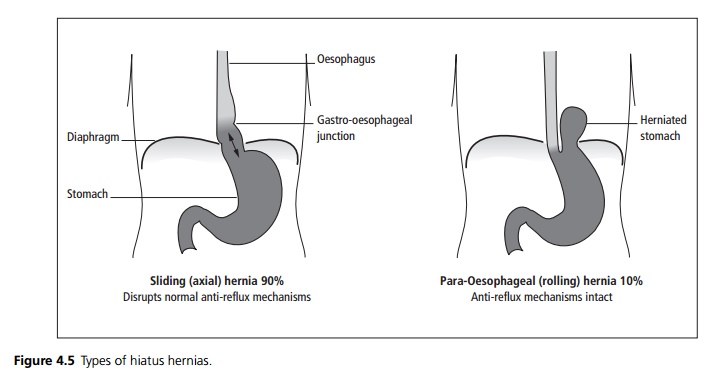Chapter: Medicine and surgery: Gastrointestinal system
Hiatus hernia - Disorders of the oesophagus
Hiatus hernia
Definition
Hiatus herniation is the abnormal passage of part or all of stomach through the diaphragm. It may be axial/sliding, paraesophageal/rolling or mixed.
Prevalence
Increases with age, very common in elderly patients (up to 70%).
Aetiology/pathophysiology
See Fig. 4.5.

In a sliding hernia the stomach passes up through its own opening. Sliding hernias are initially intermittent. Incompetence of the lower oesophageal sphincter results in reflux, which may cause chronic inflammation and fibrosis. This can eventually shorten the oesophagus, fixing the stomach in the thorax.
In a paraoesophageal hernia there is a defect in the diaphragm allowing the greater curve to roll upwards into the mediastinum. As the gastro-oesophageal sphincter remains in place patients do not develop reflux. Symptoms may result from pressure on the heart or lungs. These are most commonly seen in the elderly.
Clinical features
Most patients are asymptomatic. Patients with a sliding hernia may present with symptoms of dyspepsia due to gastro-oesophageal reflux. Paraoesophageal hernias may cause dyspnoea or palpitations. However 20% of patients with para-oesophageal/mixed hernias present acutely with acute upper gastrointestinal haemorrhage, strangulation, infarction or perforation of the intra-thoracic stomach.
Investigations
Chest X-ray may reveal a gas bubble above the diaphragm, diagnosis is confirmed on barium swallow which may require a head down position or pressure applied to the abdomen. Endoscopy can establish the extent and severity of inflammation and exclude oesophageal carcinoma.
Management
In sliding hernias management of symptoms is achieved either with medical anti-secretory agents or fundoplication. In fundoplication (open or laparoscopic) the gastric fundus is mobilised and wrapped around the lower end of the oesophagus. Increase in intra-gastric pressure therefore results in the closing off of the lower oesophagus. Endoscopic techniques may also be used.
In para-oesophageal hernias surgery is indicated (in fit patients) to reduce the risk of strangulation and other life-threatening complications. Surgery consists of excision of the peritoneal sac, reduction of the hernia and closure of the defect. A fundoplication is usually then performed.
Related Topics